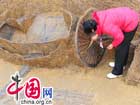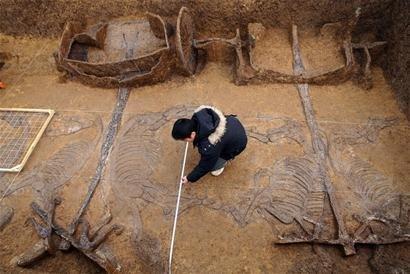| Videos | • Latest |
|
• Feature | • Sports | • Your Videos |
2000-year-old tomb unearthed

Archaeologists have unearthed a tomb that dates back more than 2,000 years in Jingmen City of China's central Hubei Province after three months excavation.
According to China Economic Newspaper, the tomb belonged to the State of Chu, one of the seven hegemonic states during the period of the Warring States (c. 11th century BC – 223 BC). Archaeologists also found 6 war chariots, remains of 14 horses, and several vessels, daggers, bronze swords and arrowheads in the tomb.
Shen Haining, provincial director of Hubei Cultural Heritage, said the unknown person buried in the tomb must have been a significant political figure at the time. Archaeologists hope to learn more from the tomb's well-preserved clues. Comparing the recent discovery with other tombs from the Chu Kingdom, "The tomb is perhaps the most-intact grave with remains of horses and chariots," Shen noted.
Huang Wenxin, a research fellow with the Hubei Archaeological Research Institute, stressed that the Chu Kingdom has few historical documents and so the artifacts from the tombs will help in the study of the culture and time of the kingdom.
"The unearthed armored command vehicle is well protected, which will help archaeologists study the Chinese military forces, particularly in the period of the Warring States," Huang said.
The Chu Kingdom reigned in the area that is now considered central and southern China. Its ruling house had the surname Mi and clan name Xiong. In its early years, Chu was a powerful, militaristic state and developed a reputation for coercing and absorbing its allies. It grew from a small, dependent state, into a large kingdom, becoming known as one of "The Five Overlord States of the Spring and Autumn Period."
The kingdom also produced a new style of poetry in Chinese literature, known as Chu Ci, which was influenced by folk songs, music and folk traditions of the time.
Print story by Wang Ke
 0
0 








Go to Forum >>0 Comments